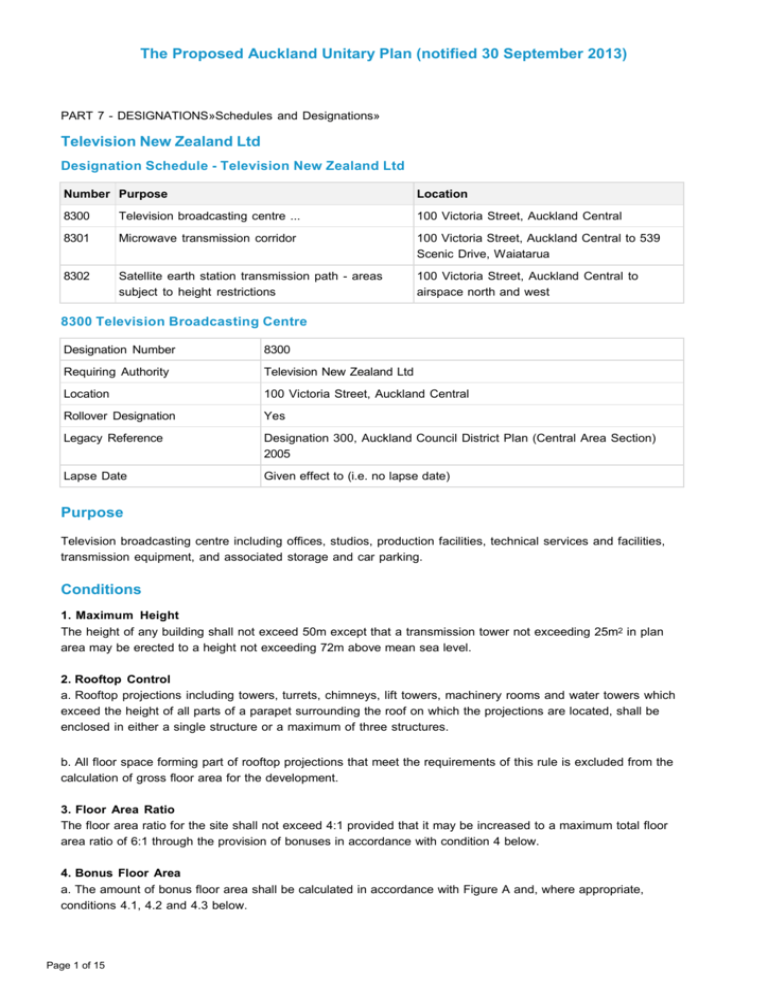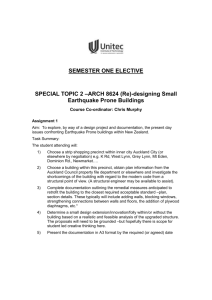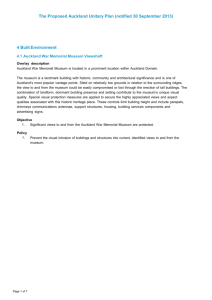Television New Zealand Ltd
advertisement

The Proposed Auckland Unitary Plan (notified 30 September 2013) PART 7 - DESIGNATIONS»Schedules and Designations» Television New Zealand Ltd Designation Schedule - Television New Zealand Ltd Number Purpose Location 8300 Television broadcasting centre ... 100 Victoria Street, Auckland Central 8301 Microwave transmission corridor 100 Victoria Street, Auckland Central to 539 Scenic Drive, Waiatarua 8302 Satellite earth station transmission path - areas subject to height restrictions 100 Victoria Street, Auckland Central to airspace north and west 8300 Television Broadcasting Centre Designation Number 8300 Requiring Authority Television New Zealand Ltd Location 100 Victoria Street, Auckland Central Rollover Designation Yes Legacy Reference Designation 300, Auckland Council District Plan (Central Area Section) 2005 Lapse Date Given effect to (i.e. no lapse date) Purpose Television broadcasting centre including offices, studios, production facilities, technical services and facilities, transmission equipment, and associated storage and car parking. Conditions 1. Maximum Height The height of any building shall not exceed 50m except that a transmission tower not exceeding 25m2 in plan area may be erected to a height not exceeding 72m above mean sea level. 2. Rooftop Control a. Rooftop projections including towers, turrets, chimneys, lift towers, machinery rooms and water towers which exceed the height of all parts of a parapet surrounding the roof on which the projections are located, shall be enclosed in either a single structure or a maximum of three structures. b. All floor space forming part of rooftop projections that meet the requirements of this rule is excluded from the calculation of gross floor area for the development. 3. Floor Area Ratio The floor area ratio for the site shall not exceed 4:1 provided that it may be increased to a maximum total floor area ratio of 6:1 through the provision of bonuses in accordance with condition 4 below. 4. Bonus Floor Area a. The amount of bonus floor area shall be calculated in accordance with Figure A and, where appropriate, conditions 4.1, 4.2 and 4.3 below. Page 1 of 15 The Proposed Auckland Unitary Plan (notified 30 September 2013) b. The area of a feature for which a bonus is obtained cannot be claimed for twice. Figure A: Bonus Feature Bonus Floor Area Available per Square Metre of Feature Provided Maximum Floor Area Ratio Limit to Bonuses on a Site Accommodation (including Non Permanent Accommodation) 2m² 2:1 Pre-school facility 3m² 1:1 Rest room 3m² 1:1 Plaza Escalators 3m² 500m² per pair 1:1 0:5:1 Light and outlook See condition 4.1 Through-site links See condition 4.2 0.5:1 Works of art See condition 4.3 1:1 Activities 4.1 Light and Outlook A bonus will be awarded where that part of a building to which CFA relates is reduced in coverage as set out in Figure B. Figure B: Where: Bonus FAR equals a. CFA < 0.3 SA 1.5:1 b. 0.3 ≤ CFA ≤ 0.8 SA 2.4-(3xCFA) : 1 SA c. CFA ≥ 8.0 SA Nil SA = site area 4.2 Through-site links a. The through-site link bonus applies to lanes, arcades and covered links which provide a separately defined, continuous and clearly identifiable public walkway taking the most direct route and providing a shorter and more convenient route than the existing alternative. b. The bonus floor area achievable per square metre of through-site link provided shall be calculated in accordance with the ratio L1:L2 where: L1 = The shortest distance between points A and B measured along the road boundary. L2 = The shortest pedestrian route between points A and B. c. Subject to the maximum FAR limited for a through-site link bonus set out in Figure A: i. the bonus floor area available per square metre of through-site link provided shall not exceed 10m2 (ie where L1:L2 = 10:1); and ii. the bonus floor area available per square metre of through-site link provided shall be no less than 5m2 (ie where L1:L2 = 5:1 or less) provided that through-site links that attain less than 2m2 shall not be eligible for a bonus. Page 2 of 15 The Proposed Auckland Unitary Plan (notified 30 September 2013) d. For the purpose of these measurements the following terms apply: i. Road boundary includes the shortest distance between points at either end of a pedestrian access which is protected by a registered easement or similar form of dedication; ii. No part of a through-site link is counted more than once for the measurement of L2; iii. Where escalator pairs are included in the through-site link they count as having zero distance except that the separate bonus available for escalator pairs still applies; iv. Where a single escalator is included in a through-site link, the calculation of L2 includes the plan distance of the escalator; and v. Where stairs are included in a through-site link their actual travel distance applies. 4.3 Works of Art a. Bonus floor area is available at the ratio of 5% extra floor area for each 1% of total construction cost spent on the commission and execution of the work of art. b. For the purpose of calculating the extra floor area which can be claimed, 5% shall be taken off the total floor area which has resulted from the addition of: i. The floor area permitted by the basic floor area ratio; ii. All bonus floor area claimed and awarded (apart from the extra floor area claimed for provision of a work of art); iii. Areas contained within a building occupied by pedestrian facilities for which consent has been granted; and iv. Areas in entrance foyer/lobby or part thereof being a primary means of access to a building which is open to the public, is accessed directly from a public place and has an overhead clearance of not less than 6m. c. A certificate prepared and signed by a registered quantity surveyor or registered architect shall be supplied to the Council to verify the total construction cost, land cost and cost of the proposed work of art. d. If a fraction of the 1% of total construction cost is spent on the commission and execution of the work, the amount of extra floor area granted shall be increased or reduced in the same proportion. 5. Screening Where any outdoor storage, service or refuse disposal area adjoins or directly faces a road or other public open space or a residential precinct, such areas, excluding access ways to off street loading bays, shall be screened from the road, public open space or residential precinct by a solid wall or fence not less than 1.8m in height. 6. Parking and Loading 6.1 The maximum number of parking spaces shall not exceed one space per 200 sqm of GFA. 6.2 The following shall be the minimum number of loading spaces to be provided: Gross Floor Area of Activity (sq m) Number of Loading Spaces 0 - 20,000 1 20,001 - 50,000 2 (one on-street for courier services) Over 50,000 3 + 1 per 37,160 sq m (one on-street for courier services) 6.3 The area of any required loading and permitted parking space(s), vehicular access drives and aisles provided within a building shall be excluded from the assessment of gross floor area of that building for the purpose of ascertaining the total number of spaces required. Page 3 of 15 The Proposed Auckland Unitary Plan (notified 30 September 2013) 6.4 Where an assessment of the permitted parking or required loading standards results in a fractional space, any fraction under one half shall be disregarded and any faction of one half or more shall be counted as one space. 7. Formation of Parking and Loading Areas 7.1 Every permitted parking and/or required loading space shall: a. Have dimensions in accordance with Table A Manoeuvring & Parking Space Dimensions; b. Be provided with such access drives and aisles as necessary for vehicles travelling to and from the road, and for the manoeuvring of vehicles within the site; and c. Be located on the same site as the activity to which it relates, be available at all times and shall have adequate useable access to that activity or building. Each loading space shall be adjacent to an adequate area for goods handling and shall be convenient to any service area or service lift. 7.2 In addition, every loading space shall be of useable shape and shall be of the following dimensions: a. Not less than 8m in depth; b. Notwithstanding anything to the contrary in paragraph a) above, for articulated vehicles, not less than 11m in depth; and c. For adequate manoeuvring, not less than 3.5m in width, or such greater width as is required) not less than 3.8m in height. 7.3 All parking and loading spaces, access drives, manoeuvring areas and aisles shall be formed, provided with an all-weather surface, drained, marked out or delineated, and maintained. 7.4 Required loading areas must be kept clear and available at all times, free of charge and impediment, for vehicles used in conjunction with the particular activity to which the loading spaces relate on the site, and shall not be used for the depositing or storage of any goods or materials or for any other purpose. 7.5 The maximum gradients for parking surfaces and floors shall be 1:16 transversely, and 1:20 longitudinally along the direction of the space. For service and manoeuvring areas the gradient shall not exceed 1:12.5 and shall be kept to a minimum. 7.6 Where a parking or manoeuvring area is adjacent to a road, a kerb or similar barrier, not less than 150mm high and at least 600mm from the road boundary, shall be provided on those parts of the frontage not used for vehicular access. Page 4 of 15 The Proposed Auckland Unitary Plan (notified 30 September 2013) Table A - Manoeuvring and parking space dimensions: Parking Angle Width of Parking Space Kerb Overhang Depth of Parking Space Manoeuvring Space Total Depth One Row Total Depth Two Rows 90o Regular Users* 2.3(a) 2.4(b) 2.5 2.6 2.7 ≥2.75 1.0 4.9 8.3 7.1 6.7 6.3 5.9 5.9 13.2 12.0 11.6 11.2 10.8 10.8 18.1 16.9 16.5 16.1 15.7 15.7 90o Casual Users* 2.5 2.6 2.7 ≥2.75 1.0 4.9 8.1 7.1 6.7 6.6 13.0 12.0 11.6 11.5 17.9 16.9 16.5 16.4 75o 2.3(a) 2.4(b) 2.5 2.6 2.7 ≥2.75 1.0 5.2 7.0 6.5 6.0 5.7 5.0 4.3 12.2 11.7 11.2 10.9 10.2 9.5 17.4 16.9 16.4 16.1 15.4 14.7 60o (3) 2.3(a) 2.4(b) 2.5 2.6 2.7 ≥2.75 1.0 5.2 5.0 4.6 4.1 3.5 3.3 3.2 10.2 9.8 9.3 8.7 8.5 8.4 15.4 15.0 14.5 13.9 13.7 13.6 45o (3) 2.3(a) 2.4(b) 2.5 2.6 2.7 ≥2.75 0.8 4.9 3.3 2.9 2.7 2.5 2.4 2.3 8.2 7.8 7.6 7.4 7.3 7.2 13.1 12.7 12.5 12.3 12.2 12.1 30o (3) 2.3(a) 2.4(b) 2.5 2.6 2.7 ≥2.75 0.6 4.0 2.5 2.4 2.4 2.4 2.3 2.3 6.5 6.4 6.4 6.4 6.3 6.3 10.5 10.4 10.4 10.4 10.3 10.3 Parallel (3) 5.9 6.1 6.3 0.4 2.5 3.6 3.3 3.0 6.1 5.8 5.5 8.6 8.3 8.0 * Regular users are people whose regular use gives them a familiarity with the building that permits smaller safe clearances between vehicles and parts of buildings. Casual users are people (usually short-term visitors) who would not be familiar with the building layout. Notes: a. Stall widths of 2.3m should only be used where users are familiar with the carpark, and parking is long term. This stall width does not meet the requirements of the Building Code. b. Stall widths of 2.4m should generally only be used where users are familiar with the carpark. This stall width does not meet the requirements of the Building Code for Casual Users. c. Minimum aisle widths are 3.5m for a one-way aisle, and 5.5m for a two-way aisle. Where an aisle serves Page 5 of 15 The Proposed Auckland Unitary Plan (notified 30 September 2013) more than 50 spaces, it should be designed as a circulation route in which case the minimum width for a twoway aisle increases to 6.5m. Note that the Building Code requires an extra 0.8m width where pedestrians use a vehicle circulation route. d. Stall widths shall be increased by 0.3m where they abut obstructions such as columns or walls. e. All overhang areas shall be kept clear of objects greater than 150mm in height. f. Where parallel end spaces have direct access through the end of the stall the length of the stall may be reduced to 5.4m. g. One-way traffic is assumed for angle spaces. h. Carparks shall have a height of at least 2.3m over the full area of the space, except where special provision is made to divert 'over-height' vehicles, in which case the minimum height may be reduced to 2.1m. i. Linear interpolation is permitted for stall width, parking angle and aisle width. 8. Access 8.1 Access to Site a. Every parking and loading space shall have access from a road, in accordance with the following standards: i. For carparks not providing access to loading, an unobstructed carriageway not less than 4.5m wide or entrance and exit carriageways, each not less than 2.4m wide. ii. For access to loading, an unobstructed carriageway not less than 6m wide or entrance and exit carriageways, each not less than 3m wide. b) All bends in the carriageway are to be designed in accordance with the appropriate design vehicle. c. The grade of access shall not be steeper than 1 in 4 for carparks not providing access to loading, and 1 in 8 for access to loading. For curved ramps and driveways, the gradient is measured along the inside radius. Ramps or driveways terminating on a grade steeper than 1 in 20 prior to the road reserve shall be provided with a platform not steeper than 1 in 20, located adjacent to the road boundary. For land not providing access to loading, the length of the platform shall not be less than 4m, and for land providing access to loading, not less than 6m. Where the driveway gradient is steeper than 1 in 8, a transition section will be required to avoid inadequate ground clearance. d. No building or building platform served by the access is to be more than 90m from a fire hydrant. e. Where the width of a carriageway is less than 3m it is to be contained within a corridor 4.5m high and clear of buildings or parts of buildings. 8.2 Vehicular access over footpaths a. Vehicular crossing over footpaths shall comply with the following: i. No more than one crossing will be permitted. However, additional crossings may be approved as a restricted discretionary activity. ii. The maximum width of any crossing at the road frontage boundary of the site shall be 6m. iii. The total crossing width for any front or corner site shall not exceed 50% of the frontage to any road in which it is placed. iv. Any access shall be so graded as to abut the road boundary at the relative level of the existing footpath. b. Where entrance locations are altered, crossings no longer required shall be reinstated as verge and/or footpath and the kerbs replaced. 8.3 Reverse manoeuvring Sufficient space shall be provided on the site so that no reverse manoeuvring on or off the road is necessary by the vehicles using the parking or loading space. 9. Definitions Average floor area Average Floor Area (AFA) is the average of the horizontal areas measured at 1.5 metres above all floor levels from the external faces of the building, including all voids and the thickness of external and internal walls, provided that: a. Basement space as defined in this rule shall be exempt from the AFA calculation; b. Approved pedestrian amenities and facilities such as through-site links, footpaths widening and escalators Page 6 of 15 The Proposed Auckland Unitary Plan (notified 30 September 2013) shall be exempt from the calculation; c. For sites with a gross site area greater than 2,000 square metres, where the horizontal area at any floor level totals less than 400 square metres, then the horizontal area at that level shall be deemed to be 400 square metres for the purpose of calculating AFA; d. A void forming an integral part of an entrance lobby - foyer (being a primary means of public access to a building) which is open to the public and accessed directly from a public place, shall be exempt from the AFA calculation. Basement Basement means any building storey the greater part of the volume of which is below mean street level. Except that for the purpose of calculating average floor area (AFA) and gross floor area (GFA) for a building on a through-site basement means for AFA and GFA: i) any space within any building storey where the greater part of the volume of that storey is below the mean street level of the lower frontage ii) any space used for carparking (including manoeuvring areas, access aisles and access ramps) occupying any building storey the greater part of the volume of which is below mean street level of the upper frontage to the midpoint measured horizontally between the upper frontage and the lower frontage (see diagram below). Calculated floor area (CFA) Average floor area calculated by averaging the area of that floor or part of the floor immediately below a horizontal plane 12.5 metres above mean street level and all floors above that plane. Floor area ratio Floor area ratio (FAR) means the relationship between building gross floor area and land area of the site, and is expressed by the formula: FAR = grossfloorarea land area of the site For the purpose of computing FAR, land area of the site excludes: a. Any part of adjoining roads and any portion of the site affected by building lines for the purpose of future road widening unless specifically provided for in this Plan. b. Any part of the site which is made up of the an interest in any airspace above or subsoil below a road. Gross floor area Gross floor area (GFA) is the sum of the gross of the several floors of all buildings on a site measured from the exterior faces of the exterior walls, or from the centre lines of walls separating two buildings or, in the absence of walls, from the exterior edge of the floor. The measurement point hall be at 1.5 metres above floor level, except for terraces (open or roofed), external balconies and porches when the measurement point shall be at floor level. In particular gross floor area includes: a. Voids except as otherwise provided, where vertical distance between storey levels exceeds 6.0 metres, the gross floor area of the building or part of the building so affected shall be taken as the volume of that airspace in cubic metres divided by 3.6. b. Basement space except as specifically excluded by this definition. c. Elevator shafts, stairwells and lobbies at each floor unless specifically excluded by this definition. d. Interior roof space providing headroom of 2.0 metres or more whether or not a floor has been laid. e. Floor spaces in interior balconies and mezzanines. f. Floor space in terraces (open or roofed), external balconies, porches if more than 75% of the perimeter of these spaces is enclosed, except that a parapet not higher than 1.2 metres or a railing not higher than 1.4 metres shall not constitute an enclosure. g. Car parking spaces permitted including driveways, aisles and manoeuvring aisles other than car parking in basement space. h. All other floor space not specifically excluded. The gross floor area of the building shall not include: i. Uncovered steps ii. Interior roof space and storage areas having less than 2.0 metres headroom; iii. Floor space in terraces (open or roofed), external balconies, or porches where not more than 75% of the perimeter of these spaces is enclosed and where a parapet not higher than 1.2 metres or a railing not higher than 1.4 metres does not constitute an enclosure; iv. Pedestrian facilities approved by the Council and eligible for bonus floor space; v. Pedestrian circulation space; vi. Basement space for stairs, escalators and elevators essential to the operation of a through-site link whether or not such a link qualifies for bonus floor space, or servicing a floor used primarily for car parking or loading; Page 7 of 15 The Proposed Auckland Unitary Plan (notified 30 September 2013) vii. Other basement space to an equivalent maximum FAR of 1 except that the space excluded shall not be used in the calculation of permitted parking viii. Required off-street loading spaces; ix. Car parking in basement space (including manoeuvring areas, access aisles and access ramps) except that the space excluded shall not be used in the calculation of permitted parking; x. Non-habitable floor space in rooftop structures; and xi. any entrance foyer/lobby or part of it including the void forming an integral part of it (being a primary means of access to a building), which is open to the public, is accessed directly from a public place and has an overhead clearance of not less than 6.0 metres. Rooftop Rooftop includes the roof of building podiums in addition to its ordinary meeting. Rooftop projections do not include: i. Any part of a building included in the definition of gross floor area. ii. Any roof top ornamental projections including finials, turrets, towers, cupola, pediments and cornices integral to the design of the building; and iii. Telecommunications antennas and aerials. Total construction cost For the purposes of condition 4.3 Total Construction Cost means the total cost of completing the development (or in the case of an existing development, the replacement cost of that development) for which extra floor area is claimed to be an initial tenantable condition, including all external and internal structural walls of the building to a finished standard (but excluding nonDstructural partitioning and furnishings); all building services; floor coverings; and all site works but not including land cost or the cost of the proposed work of art. Attachments No attachments. 8301 Microwave Transmission Corridor Designation Number 8301* Requiring Authority Television New Zealand Ltd Location 100 Victoria Street West, Auckland Central to Ponsonby Road, Ponsonby Rollover Designation Yes Legacy Reference Designation 301, Auckland Council District Plan (Central Area Section) 2005 Lapse Date Given effect to (i.e. no lapse date) * Indicates this is a joint Television New Zealand Ltd and Kordia Ltd (Designation 3300) designation from 100 Victoria Street West, Auckland Central to Ponsonby Road, Ponsonby. Kordia Ltd designation only from Ponsonby Road to 501 Scenic Drive, Waiatarua. Purpose Microwave Transmission Corridor - a protection corridor of specified height (elevation above sea level) and width through which no building, structure or tree can pass to ensure continuity of a microwave linking / transmission path from the TVNZ Broadcasting Centre at 100 Victoria Street West, Central Auckland to the Waiatarua Transmission Station at 539 Scenic Drive, Waiatarua. Conditions Page 8 of 15 The Proposed Auckland Unitary Plan (notified 30 September 2013) 1. All masts, antennas, aerials and other facilities must comply with New Zealand Standard NZS6609: 1990 or any amendments, at all times. The following table shows, at specific points along the path of the corridor, the width of the corridor and the base-height of the corridor. Intermediate widths and heights shall be determined by extending straight lines between adjacent points. Path Length (KM) Page 9 of 15 Corridor Width (m) Maximum Obstruction Height above Mean Sea Level (m) 0.000 (a) 6.8 62.6 0.025 0.050 6.8 6.8 63.0 63.4 0.075 6.8 63.8 0.100 6.8 64.2 0.125 0.150 6.8 6.8 64.6 65.0 0.175 6.8 65.4 0.200 6.8 65.8 0.225 0.250 6.8 6.8 66.2 66.6 0.275 6.8 67.0 0.300 6.8 67.3 0.325 0.350 6.8 6.8 67.7 68.1 0.375 6.8 68.5 0.400 6.8 68.9 0.425 0.450 6.8 6.8 69.3 69.7 0.475 6.8 70.1 0.500 6.8 70.5 0.525 0.550 6.8 6.8 70.9 71.3 0.575 6.8 71.7 0.600 6.8 72.1 0.625 0.650 6.8 6.8 72.5 72.9 0.675 6.8 73.3 0.700 6.8 73.7 0.725 0.750 6.8 6.8 74.1 74.5 0.775 6.8 74.9 0.800 6.8 75.3 0.825 0.850 6.8 6.8 75.7 76.1 0.875 6.8 76.5 0.900 6.9 76.8 0.925 0.950 7.0 7.1 77.2 77.6 0.975 7.2 77.9 1.000 7.3 78.3 The Proposed Auckland Unitary Plan (notified 30 September 2013) Page 10 of 15 Path Length (KM) Corridor Width (m) Maximum Obstruction Height above Mean Sea Level (m) 1.10 7.6 79.7 1.20 1.30 7.9 8.2 81.1 82.6 1.40 8.5 84.1 1.50(b) 8.8 85.5 1.60 1.70 9.1 9.3 87.0 88.5 1.80 9.6 90.0 1.90 9.8 91.5 2.00 2.10 (c) 10.0 10.2 93.0 94.5 2.20 10.4 96.1 2.30 10.6 97.6 2.40 2.50 10.8 11.0 99.1 100.7 2.60 11.2 102.2 2.70 11.4 103.8 2.80 2.90 11.6 11.7 105.3 106.9 3.00 11.9 108.4 3.10 12.1 110.0 3.20 3.30 12.2 12.4 111.6 113.2 3.40 12.5 114.7 3.50 (d) 12.7 116.3 3.60 3.70 12.8 12.9 117.9 119.5 3.80 13.1 121.1 3.90 13.2 122.7 4.00 4.5 13.3 13.9 124.3 132.4 5.0 14.4 140.6 5.5 14.8 148.8 6.0 6.5 15.2 15.5 157.2 165.6 7.0 15.8 174.2 7.5 16.0 182.8 8.0 8.5 16.2 16.3 191.4 200.2 9.0 16.4 209.0 9.5 16.4 218.0 10.0 16.4 227.0 10.5 11.0 16.4 16.3 236.0 245.2 11.5 16.1 254.4 12.0 15.9 263.7 12.5 15.7 273.1 The Proposed Auckland Unitary Plan (notified 30 September 2013) Path Length (KM) Corridor Width (m) Maximum Obstruction Height above Mean Sea Level (m) 13.0 15.4 282.6 13.5 14.0 15.1 14.7 292.1 301.8 14.5 14.2 311.5 15.0 13.7 321.3 15.5 16.0 13.1 12.4 331.2 341.2 16.5 11.6 351.4 17.0 10.6 361.6 17.5 18.0 9.6 8.2 372.0 382.5 18.5 6.8 393.2 19.0 6.8 403.2 19.1 19.2 6.8 6.8 405.2 407.2 19.3 (e) 6.8 409.2 Key specific points: a. Network Centre; b. Ponsonby Road; c. Corner of Richmond Road and Chamberlain Street; d. Corner of Old Mill Road and West View Road; and e. Waiataru. 2. Any significant increase in radio frequency energy levels from this source shall comply with the Auckland City Consolidated Bylaw 1991 and any statutory regulation controlling radio frequency exposure levels. Attachments Cross-sections of Land Contour and Path Height Page 11 of 15 The Proposed Auckland Unitary Plan (notified 30 September 2013) Page 12 of 15 The Proposed Auckland Unitary Plan (notified 30 September 2013) Kordia Technical Paper on Corridor Dimension and Radio Frequency Emissions Click here for PDF Page 13 of 15 The Proposed Auckland Unitary Plan (notified 30 September 2013) 8302 Satellite Earth Station Transmission Path Designation Number 8302 Requiring Authority Television New Zealand Ltd Location 100 Victoria Street West to airspace north and west, Auckland Central Rollover Designation Yes Legacy Reference Designation 302, Auckland Council District Plan (Central Area Section) 2005; and Designation B07-90, Auckland Council District Plan (Isthmus Section) 1999 Lapse Date Given effect to (i.e. no lapse date) Purpose Satellite earth station transmission path - areas subject to height restrictions. The areas subject to height restrictions are shown in diagram in Attachment 1. Conditions 1. All masts, antennas, aerials and other radiocommunication facilities must comply with New Zealand Standard NZS2772.1:1999 or any amendments, at all times. Attachments TVNZ Satellite Earth Station Transmission Path - Proposed Building Height Limits (Drawing 134706SC01 RevA) Page 14 of 15 The Proposed Auckland Unitary Plan (notified 30 September 2013) Page 15 of 15





